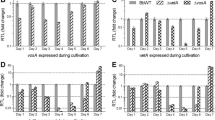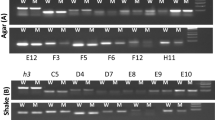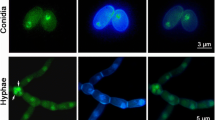Abstract
Aerial conidia are central dispersing structures for most fungi and represent the infectious propagule for entomopathogenic fungus Beauveria bassiana, thus the active ingredients of commercial mycoinsecticides. Although a number of formic-acid-extractable (FAE) cell wall proteins from conidia have been characterized, the functions of many such proteins remain obscure. We report that a conidial FAE protein, termed CP15, isolated from B. bassiana is related to fungal tolerance to thermal and oxidative stresses. The full-length genomic sequence of CP15 was shown to lack introns, encoding for a 131 amino acid protein (15.0 kDa) with no sequence identity to any known proteins in the NCBI database. The function of this new gene with two genomic copies was examined using the antisense-RNA method. Five transgenic strains displayed various degrees of silenced CP15 expression, resulting in significantly reduced conidial FAE protein profiles. The FAE protein contents of the strains were linearly correlated to the survival indices of their conidia when exposed to 30-min wet stress at 48°C (r 2 = 0.93). Under prolonged 75-min heat stress, the median lethal times (LT50s) of their conidia were significantly reduced by 13.6–29.5%. The CP15 silenced strains were also 20–50% less resistant to oxidative stress but were not affected with respect to UV-B or hyperosmotic stress. Our data indicate that discrete conidial proteins may mediate resistance to some abiotic stresses, and that manipulation of such proteins may be a viable approach to enhancing the environmental fitness of B. bassiana for more persisting control of insect pests in warmer climates.




Similar content being viewed by others
References
Aguado C, Rufz-Herrera J, Iranzo M, Sentandreu R, Mormeneo S (1998) Reaggregation and binding of cell protein from Candida albican to structural polysaccharides. Res Microbiol 149:327–338
Bidochka MJ, St Leger RJ, Joshi L, Robert DW (1995a) The rodlet layer from aerial and submerged conidia of entomopathogenic fungus Beauveria bassiana contains hydrophobin. Mycol Res 99:403–406
Bidochka MJ, St Leger RJ, Joshi L, Robert DW (1995b) An inner cell wall protein (cwp1) from conidia of the entomopathogenic fungus Beauveria bassiana. Microbiology 141:1075–1080
Bidochka MJ, Clark DC, Lewis MW, Keyhani NO (2010) Could insect phagocytic avoidance by entomogenous fungi have evolved via selection against soil amoeboid predators? Microbiology 156:2164–2171
Boucias DG, Pendland JC, Latge JP (1988) Nonspecific factors involved in attachment of entonomopathogenic Deuterromycetes to host insect cuticle. Appl Environ Microbiol 54:1795–1805
Cho EM, Kirkland BH, Holder DJ, Keyhani NO (2007) Phage display cDNA cloning and expression analysis of hydrophobins from the entomopathogenic fungus Beauveria (Cordyceps) bassiana. Microbiology 153:3438–3447
de Backer MD, Raponi M, Arndt GM (2002) RNA-mediated gene silencing in non-pathogenic and pathogenic fungi. Curr Opin Microbiol 5:323–329
de Vocht ML, Scholtmeijer K, van der Vegte EW, de Vries OMH, Sonveaux N, Wösten HAB, Ruysschaert JM, Hadziioannou G, Wessels JGH, Robillard GT (1998) Structural characterization of the hydrophobin SC3, as a monomer and after self-assembly at hydrophobic/hydrophilic interfaces. Biophys J 74:2059–2068
Fang WG, Leng B, Xiao YH, Jin K, Ma JC, Fan YH, Feng J, Yang XY, Zhang YJ, Pei Y (2005) Cloning of Beauveria bassiana chitinase gene Bbchit1 and its application to improve fungal strain virulence. Appl Environ Microbiol 71:363–370
Fang WG, Scully LR, Zhang L, Pei Y, Bidochka MJ (2008) Implication of a regulator of G protein signalling (BbRGS1) in conidiation and conidial thermotolerance of the insect pathogenic fungus Beauveria bassiana. FEMS Microbiol Lett 279:146–156
Fang WG, Feng J, Fan YH, Zhang YJ, Bidochka MJ, St Leger RJS, Pei Y (2009) Expressing a fusion protein with protease and chitinase activities increases the virulence of the insect pathogen Beauveria bassiana. J Invertebr Pathol 102:155–159
Feng MG, Poprawski TJ, Khachatourians GG (1994) Production, formulation and application of the entomopathogenic fungus Beauveria bassiana for insect control: current status. Biocontrol Sci Technol 4:3–34
Gribun A, Kactoff DJ, Hershkovits G, Pechatnikov I, Nitzan Y (2004) Cloning and characterization of the gene encoding for OMP-PD porin: the major Photobacterium damsela outer membrane protein. Curr Microbiol 48:167–174
Holder DJ, Keyhani NO (2005) Adhesion of the entomopathogenic fungus Beauveria (Cordyceps) bassiana to substrata. Appl Environ Microbiol 71:5260–5266
Huang BF, Feng MG (2009) Comparative tolerances of various Beauveria bassiana isolates to UV-B irradiation with a description of a modeling method to assess lethal dose. Mycopathologia 168:145–152
Imazu H, Sakurai H (2005) Saccharomyces cerevisiae heat shock transcription factor regulates cell wall remodeling in response to heat shock. Eukaryot Cell 4:1050–1056
Inglis GD, Johnson DL, Goettel MS (1997) Efftects of temperature and sunlight on mycosis (Beauveria bassiana) (Hyphomycetes: Sympodulosporae) of grasshoppers under field conditions. Environ Entomol 26:400–409
Jagdale GB, Grewal PS (2003) Acclimation of entomopathogenic nematodes to novel temperatures: trehalose accumulation and the acquisition of thermotolerance. Int J Parasitol 33:145–152
Jeffs LB, Xavier HJ, Matai RE, Khachatourians GG (1999) Relationships between fungal spore morphologies and surface properties for entomopathogenic members of the genus Beauveria, Metarhizium, Paecilomyces, Tolypocladium, and Verticillium. Can J Microbiol 45:936–948
Jin K, Zhang YJ, Fang WG, Luo ZB, Zhou YH, Pei Y (2010) Carboxylate transporter gene JEN1 from the entomopathogenic fungus Beauveria bassiana is involved in conidiation and virulence. Appl Environ Microbiol 76:254–263
Klis FM, Mol P, Hellingwerf K, Brul S (2002) Dynamics of cell wall structure in Saccharomyces cerevisiae. FEMS Microbiol Rev 26:239–256
Lewis MW, Robalino IV, Keyhani NO (2009) Uptake of the fluorescent probe FM4-64 by hyphae and haemolymph-derived in vivo hyphal bodies of the entomopathogenic fungus Beauveria bassiana. Microbiology 155:3110–3120
Li J, Feng MG (2009) Intraspecific tolerance of Metarhizium anisopliae conidia to the upper thermal limits of summer with a description of a quantitative assay system. Mycol Res 113:93–99
Li J, Ying SH, Shan LT, Feng MG (2010) A new non-hydrophobic cell wall protein (CWP10) of Metarhizium anisopliae enhances conidial hydrophobicity when expressed in Beauveria bassiana. Appl Microbiol Biotechnol 85:975–984
Lindquist S, Kim G (1996) Heat-shock protein 104 expression is sufficient for thermotolerance in yeast. Proc Natl Acad Sci USA 93:5301–5306
Livak KJ, Schmittgen TD (2001) Analysis of relative gene expression data using real-time quantitative PCR and the \( {2^{ - \Delta \Delta {\text{Ct}}}} \) method. Methods 25:402–408
Lomer CJ, Bateman RP, Johnson DL, Langewald J, Thomas M (2001) Biological control of locusts and grasshoppers. Annu Rev Entomol 46:667–702
Mankel A, Krause K, Kothe E (2002) Identification of a hydrophobin gene that is developmentally regulated in the ectomycorrhizal fungus Tricholoma terreum. Appl Environ Microbiol 68:1408–1413
Morozova EV, Baranova MV, Kozlov VP, Tereshina VM, Memorskaya AS, Feofilova EP (2001) Peculiarities of exogenous dormancy of Aspergillus niger conidia. Microbiology 70:527–534
Nakayashiki H (2005) RNA silencing in fungi: mechanisms and applications. FEBS Lett 579:5950–5957
Noventa-Jordao MA, Couto RM, Goldman MHS, Aguirre J, Lyer S, Caplan A, Terenzi H, Goldman GH (1999) Catalase activity is necessary for heat-shock recovery in Aspergillus nidulans germlings. Microbiology 145:3229–3234
Punt PJ, Dingemanse MA, Kuyvenhoven A, Soede RDM, Pouwels PH, van den Hondel CAMJJ (1990) Functional elements in the promoter region of the Aspergillus nidulans gpdA gene encoding glyceraldehyde-3-phosphate dehydrogenase. Gene 93:101–109
Raeder U, Broda P (1985) Rapid preparation of DNA from filamentous fungi. Lett Appl Microbiol 1:17–20
Saito K, Yamazaki H, Ohnishi Y, Fujimoto S, Takahashi E, Horinouchi S (1998) Production of trehalose synthase from a basidiomycete, Grifola frondosa, in Escherichia coli. Appl Microbiol Biotechnol 50:193–198
Sakthivel K, Watanabe T, Nakamoto H (2009) A small heat-shock protein confers stress tolerance and stabilizes thylakoid membrane proteins in cyanobacteria under oxidative stress. Arch Microbiol 191:319–328
Shan LT, Wang ZL, Ying SH, Feng MG (2010) Hydrophobicity-related protein contents and surface areas of aerial conidia are useful traits for formulation design of fungal biocontrol agents. Mycopathologia 169:483–494
Tabaska JE, Zhang MQ (1999) Detection of polyadenylation signals in human DNA sequences. Gene 231:77–86
Temple B, Horge PA, Bernier L, Hintz WE (1997) Cerato-ulmin, a hydrophobin secreted by the causal agents of Ducth elm disease, is a parasitic fitness factor. Fungal Genet Biol 22:39–53
Thevelein JM (1984) Regulation of trehalose mobilization in fungi. Microbiol Rev 48:42–59
Wanchoo A, Lewis MW, Keyhani NO (2009) Lectin mapping reveals stage-specific display of surface carbohydrates in vitro and haemolymph-derived cells of the entomopathogenic fungus Beauveria bassiana. Microbiology 155:3121–3133
Wessels JGH (1994) Developmental regulation of fungal cell wall formation. Annu Rev Phytopathol 32:413–437
Wessels JGH, de Vries OMH, Asgeirsdottir SA, Schuren FHJ (1991) Hydrophobin genes involved in formation of aerial hyphae and fruit bodies in Schizophyllum commune. Plant Cell 3:793–799
Whiteford JR, Spanu PD (2001) The hydrophobin HCf-1 of Cladosporium fulvum is required for efficient water-mediated dispersal of conidia. Fungal Genet Biol 32:159–168
Wösten HAB (2001) Hydrophobins: multipurpose proteins. Annu Rev Microbiol 55:625–646
Xie XQ, Wang J, Huang BF, Ying SH, Feng MG (2010) A new manganese superoxide dismutase identified from Beauveria bassiana enhances virulence and stress tolerance when overexpressed in the fungal pathogen. Appl Microbiol Biotechnol 86:1543–1553
Ye SD, Ying SH, Chen C, Feng MG (2006) New solid-state fermentation chamber fits up bulk production of aerial conidia of fungal biocontrol agents on rice. Biotechnol Lett 28:799–804
Ying SH, Feng MG (2004) Relationship between thermotolerance and hydrophobin- like proteins in aerial conidia of Beauveria bassiana and Paecilomyces fumosoroseus as fungal biocontrol agents. J Appl Microbiol 97:323–331
Ying SH, Feng MG (2006) Novel blastospore-based transformation system for integration of phosphinothricin resistance and green fluorescence protein genes into Beauveria bassiana. Appl Microbiol Biotechnol 72:206–210
Zhang YJ, Zhao JH, Fang WG, Zhang JQ, Luo ZB, Zhang M, Fang YH, Pei Y (2009) Mitogen-activated protein kinase hog1 in the entomopathogenic fungus Beauveria bassiana regulates environmental stress responses and virulence to insects. Appl Environ Microbiol 75:3787–3795
Zhang S, Fan Y, Xia YX, Keyhani NO (2010) Sulfonylurea resistance as a new selectable marker for the entomopathogenic fungus Beauveria bassiana. Appl Microbiol Biotechnol 87:1151–1156
Zou G, Ying SH, Shen ZC, Feng MG (2006) Multi-sited mutations of beta-tubulin are involved in benzimidazole resistance and thermotolerance of fungal biocontrol agent Beauveria bassiana. Environ Microbiol 8:2095–2106
Acknowledgements
The authors expressed their sincere thanks to Nemat O. Keyhani (University of Florida, USA) for valuable comments during manuscript preparation. Funding of this study was provided jointly by the Natural Science Foundation of China (30930018 and 30971960) and the Ministry of Science and Technology (2009CB118904 and 2007DFA3100).
Author information
Authors and Affiliations
Corresponding author
Rights and permissions
About this article
Cite this article
Ying, SH., Feng, MG. A conidial protein (CP15) of Beauveria bassiana contributes to the conidial tolerance of the entomopathogenic fungus to thermal and oxidative stresses. Appl Microbiol Biotechnol 90, 1711–1720 (2011). https://doi.org/10.1007/s00253-011-3205-7
Received:
Revised:
Accepted:
Published:
Issue Date:
DOI: https://doi.org/10.1007/s00253-011-3205-7




